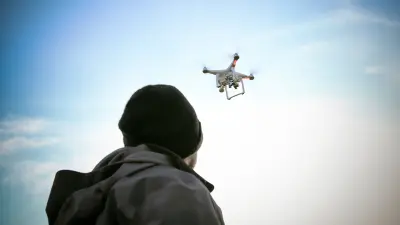Creating an anti-drone system for airports

When a drone is detected in the airfield, it can be a threat for airports. But with an anti-drone system and countermeasure strategies in place, operators can prevent disruptions to the runway and airspace.
Threats from drone technology

According to aviation experts, the danger posed by drones is real. The catastrophic damage caused when a drone collides with an airplane or when a terror organization uses armed drones presents a clear security threat to airports. At the same time, the risk of a drone incident occurring is increasing because the number of remote-controlled drones for private use, including video-equipped aerial vehicles, is now at an all-time high. Without a clear protocol or appropriate technology in place, airports are vulnerable to future costly disruptions, safety incidents, and potential security breaches.
Who then is responsible when there is a drone incident at the airport? While the safety manager would be the obvious answer, the issue is actually far more complex. Drone incidents affect airports on three levels: security, safety, and operations.
1,000 Flights Cancelled
Gatwick Airport dealt with cancelled flights and 140,000 stranded passengers in 2018 when a drone was sighted on the airside.
Determining responsibility when a drone is detected
A drone incident sets off a chain reaction at an airport. Safety managers take jurisdiction when an intruding drone near the runway would put the safety of passengers and crew in starting, landing, and flying planes at risk. Operational managers would take charge in cases of cancelled flights to prevent lost revenue for airlines. Stranded passengers in the terminal become a security issue for the security manager because they are a soft target for terrorism. However, these complex situations require that all airport stakeholders are informed and have protocols in place.
“Rather than working separately, a cross-department joint discussion about how to proactively deal with drones could be implemented. This could even be proactively triggered from the security department,” says Maarten Wings, Global Vertical Manager Airports at Bosch Security Systems. “Considering the massive operational disruption, reputational damage, passenger dissatisfaction and security risks caused by drone incidents, airports need to mount a strategic response to this growing threat, which effects all stakeholders.”

Counter drone technology meets the perimeter security system

The positive news for airport operators is that there is already counter technology on the market. However, just using radar technology to detect drones can cause safety managers to miss a critical viewpoint. A visual perspective allows operators to make a threat assessment to determine whether a drone may be carrying a foreign object (e.g. cameras or explosives).
By creating collaborative safety and security measures, airports can better detect and react to drones. Cameras installed along the airport perimeter fence can be integrated with radar technology. When radar is triggered, the software will relay the three-dimensional coordinates to the closest ground-mounted security camera to confirm that the object is a drone, and if so, keep tracking its course.
The system integration of radar detection with high-definition cameras has already been put into practice. Critically, integrating airside safety solutions with perimeter security is not only more effective for airports, but also more cost efficient. Now, the pressure is on airports to prepare for every scenario. Because when a drone breaches a perimeter, there are two types of airports: those with real-time intrusion detection and cross-departmental response protocols in place, and those caught completely by surprise.


Maarten Wings
Global Vertical Manager Airports
“Tomorrow’s ‘smart’ control rooms will be able to automate security and safety processes and also leverage data-driven insights. What our industry needs to make it happen is a mind shift from considering a security camera as an image source, to seeing it as a data sensor.”
Bosch has over 300 airports in its customer base. Through global coordination of best practice sharing and many personal airport visits, I am able to provide sustainable and effective working solutions to help airports meet their goals. As an active member of Airports Council International (ACI), I represent Bosch as a technology partner for airports. Interested? Connect with me through email or LinkedIn.
E-mail: Maarten.Wings@bosch.com
Trends & Technologies
If you are a user, buyer or planner of safety, security or communication solutions, then this is your new information hub. We created this trends and technologies to generate insights, to provide information about useful trends and to support you in creating ideas for better and more efficient solutions.